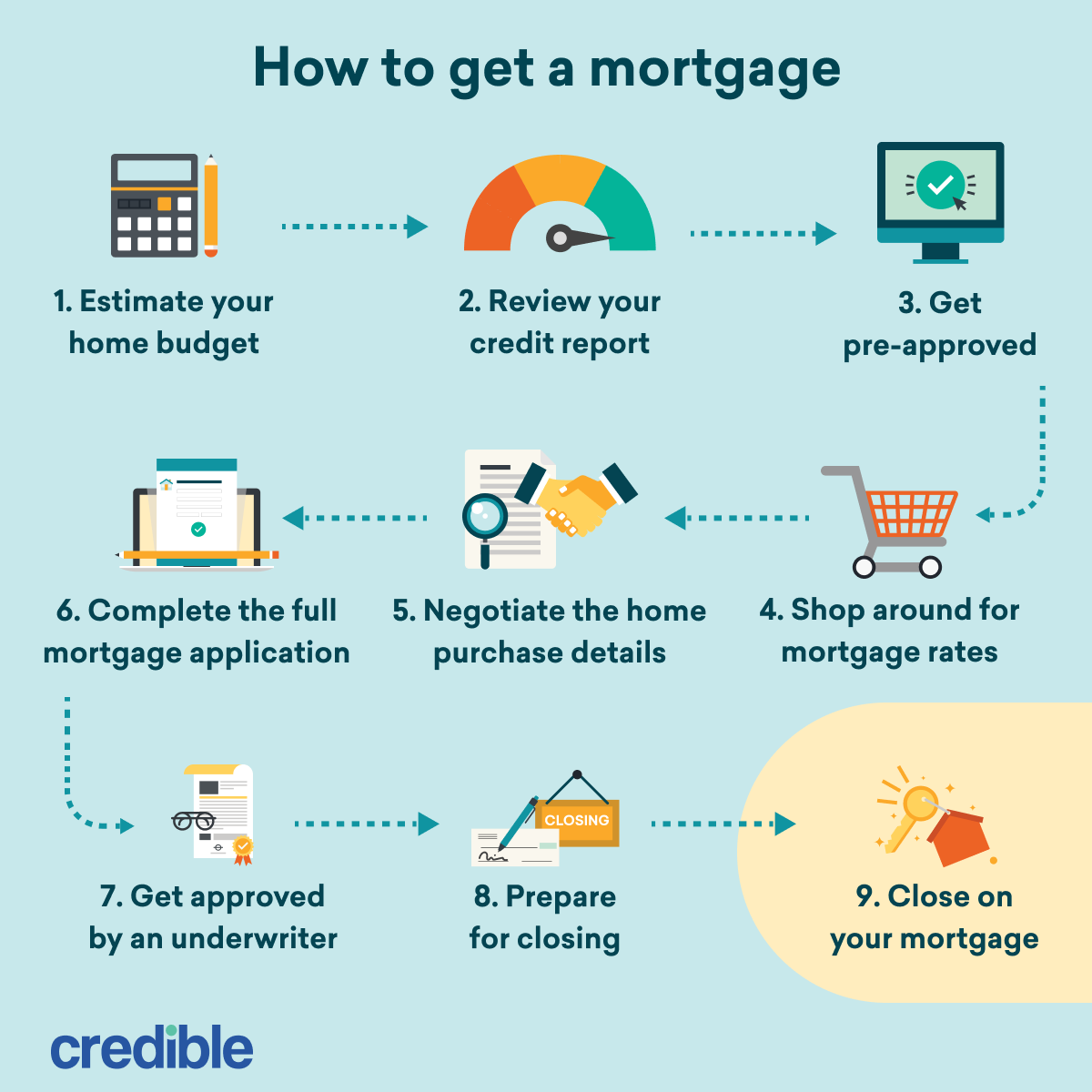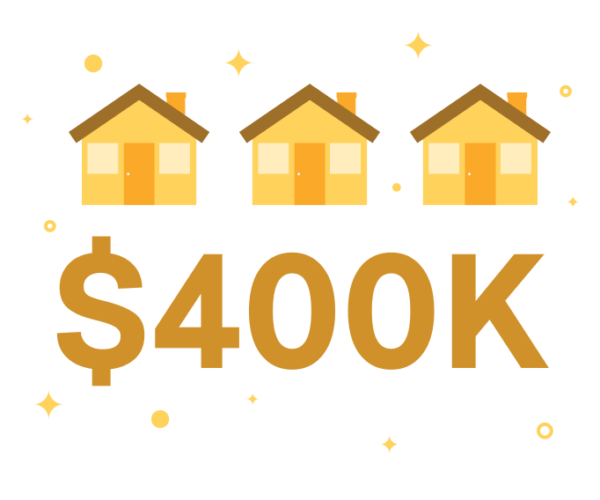Our goal is to give you the tools and confidence you need to improve your finances. Although we receive compensation from our partner lenders, whom we will always identify, all opinions are our own. Credible Operations, Inc. NMLS # 1681276, is referred to here as "Credible."
Mortgage loans come with a variety of costs — not just a monthly payment. On a mortgage as large as $400,000, these costs may be significant, so it’s important to weigh them carefully before applying for the loan.
This will ensure you can comfortably afford the mortgage — both now and in the long haul.
Learn more about how much a $400,000 mortgage will cost you throughout the life of the loan:
- Monthly payments for a $400,000 mortgage
- Where to get a $400,000 mortgage
- What to consider before applying for a $400,000 mortgage
- How to get a $400,000 mortgage
Monthly payments for a $400,000 mortgage
On a $400,000 mortgage with an interest rate of 6%, your monthly payment would be $2,398 for a 30-year loan and $3,375 for a 15-year one.
Here’s a look at what generally goes into a mortgage payment:
- Principal: This is a portion of your payment that goes straight toward whittling down your balance. It’s typically a very small share of your payment at the start of your loan.
- Interest: This covers the cost of borrowing your loan. It’s usually the largest share of your payment for the first few years of your loan.
- Escrow costs: Most lenders require you use an escrow account to stow away cash for property taxes and homeowners insurance. You’ll pay money into this account each month as part of your mortgage payment.
Here’s a quick look at what the monthly principal and interest payment would be for a $400,000 mortgage with varying rates:
Annual Percentage Rate (APR) | Monthly payment (15 year) | Monthly payment (30 year) |
|---|---|---|
6.00% | $3,375 | $1,686 |
6.25% | $3,430 | $1,740 |
6.50% | $3,484 | $1,796 |
6.75% | $3,539 | $1,852 |
7.00% | $3,595 | $1,910 |
7.25% | $3,651 | $1,968 |
7.50% | $3,708 | $2,027 |
7.75% | $3,765 | $2,866 |
8.00% | $3,823 | $2,935 |
Check out: 20- vs 30-Year Mortgage: Is an Unusual Option Right for You?
Where to get a $400,000 mortgage
Shopping around for your mortgage is critical if you want to get the lowest interest rate. To do this, you’ll need to apply to several mortgage lenders directly.
Once you have a few loan estimates in hand, you can compare the costs of each lender one by one. Make sure to look at the APR, origination fee, mortgage points, and the total cash you’ll need to bring to closing.
From there, you can choose the best offer, proceed with the lender’s full application, and provide any financial documentation they might require.
You can also use Credible to compare lender options. Our process is entirely online, and it only takes a few minutes.
What to consider before applying for a $400,000 mortgage
Before you take out a loan as large as $400,000 — or any mortgage loan, really — you’ll need to understand the total costs of the loan.
You should know what your closing costs and monthly payment will be, how much you’ll need for a down payment, and the total interest you’ll pay over time.
Total interest paid on a $400,000 mortgage
The total interest you’ll pay will depend on both your APR and the length of your loan. Longer loan terms and higher APRs will result in more interest costs in the long run.
Use Credible to compare lender options — all in one place.
Credible makes finding a mortgage easy
Compare prequalified mortgage rates from top lenders in just 3 minutes.
On a 15-year, $400,000 mortgage loan with a 6% interest rate, for example, you’d pay $207,577 in total interest by the end of your loan term.
On a 30-year loan with the same details, your interest costs would jump to $463,353 — a shocking $255,776 more.
Use the calculator below to see how much interest you’ll pay, as well as what your home will cost you every month.
Enter your loan information to calculate how much you could pay
With a $ home loan, you will pay $ monthly and a total of $ in interest over the life of your loan. You will pay a total of $ over the life of the mortgage.
Check Out: How to Buy a House: Step-by-Step Guide
Amortization schedule on a $400,000 mortgage
An amortization schedule, which breaks down the principal and interest payments for a loan, can help you understand the long-term costs of your mortgage.
As you’ll see below, the bulk of your payments will go toward interest costs. Once you get further into your loan term, more of your payments go toward your loan balance, and you’ll start reducing that principal at a faster rate.
Here’s what an amortization schedule looks like for a 30-year, $400,000 mortgage with an APR of 6%:
Year| Beginning balance | Monthly payment | Total interest paid | Total principal paid | Remaining balance |
|
|---|---|---|---|---|---|
| 1 | $400,000.00 | $2,398.20 | $23,866.38 | $4,912.05 | $395,087.95 |
| 2 | $395,087.95 | $2,398.20 | $23,563.41 | $5,215.01 | $389,872.94 |
| 3 | $389,872.94 | $2,398.20 | $23,241.76 | $5,536.66 | $384,336.28 |
| 4 | $384,336.28 | $2,398.20 | $22,900.27 | $5,878.15 | $378,458.13 |
| 5 | $378,458.13 | $2,398.20 | $22,537.72 | $6,240.70 | $372,217.43 |
| 6 | $372,217.43 | $2,398.20 | $22,152.81 | $6,625.62 | $365,591.81 |
| 7 | $365,591.81 | $2,398.20 | $21,744.16 | $7,034.27 | $358,557.54 |
| 8 | $358,557.54 | $2,398.20 | $21,310.30 | $7,468.13 | $351,089.42 |
| 9 | $351,089.42 | $2,398.20 | $20,849.68 | $7,928.74 | $343,160.67 |
| 10 | $343,160.67 | $2,398.20 | $20,360.65 | $8,417.77 | $334,742.90 |
| 11 | $334,742.90 | $2,398.20 | $19,841.46 | $8,936.96 | $325,805.94 |
| 12 | $325,805.94 | $2,398.20 | $19,290.25 | $9,488.17 | $316,317.76 |
| 13 | $316,317.76 | $2,398.20 | $18,705.04 | $10,073.38 | $306,244.38 |
| 14 | $306,244.38 | $2,398.20 | $18,083.74 | $10,694.69 | $295,549.69 |
| 15 | $295,549.69 | $2,398.20 | $17,424.11 | $11,354.31 | $284,195.38 |
| 16 | $284,195.38 | $2,398.20 | $16,723.80 | $12,054.62 | $272,140.76 |
| 17 | $272,140.76 | $2,398.20 | $15,980.30 | $12,798.13 | $259,342.63 |
| 18 | $259,342.63 | $2,398.20 | $15,190.94 | $13,587.49 | $245,755.14 |
| 19 | $245,755.14 | $2,398.20 | $14,352.89 | $14,425.53 | $231,329.61 |
| 20 | $231,329.61 | $2,398.20 | $13,463.16 | $15,315.27 | $216,014.34 |
| 21 | $216,014.34 | $2,398.20 | $12,518.55 | $16,259.88 | $199,754.47 |
| 22 | $199,754.47 | $2,398.20 | $11,515.67 | $17,262.75 | $182,491.71 |
| 23 | $182,491.71 | $2,398.20 | $10,450.94 | $18,327.48 | $164,164.23 |
| 24 | $164,164.23 | $2,398.20 | $9,320.54 | $19,457.88 | $144,706.35 |
| 25 | $144,706.35 | $2,398.20 | $8,120.42 | $20,658.00 | $124,048.35 |
| 26 | $124,048.35 | $2,398.20 | $6,846.28 | $21,932.14 | $102,116.21 |
| 27 | $102,116.21 | $2,398.20 | $5,493.56 | $23,284.87 | $78,831.34 |
| 28 | $78,831.34 | $2,398.20 | $4,057.40 | $24,721.03 | $54,110.31 |
| 29 | $54,110.31 | $2,398.20 | $2,532.66 | $26,245.77 | $27,864.55 |
| 30 | $27,864.55 | $2,398.20 | $913.88 | $27,864.55 | $0.00 |
And here’s what an amortization schedule looks like for a 15-year, $400,000 mortgage with an APR of 6%:
Year| Beginning balance | Monthly payment | Total interest paid | Total principal paid | Remaining balance |
|
|---|---|---|---|---|---|
| 1 | $400,000.00 | $3,375.43 | $23,538.46 | $16,966.67 | $383,033.33 |
| 2 | $383,033.33 | $3,375.43 | $22,491.99 | $18,013.14 | $365,020.19 |
| 3 | $365,020.19 | $3,375.43 | $21,380.98 | $19,124.15 | $345,896.05 |
| 4 | $345,896.05 | $3,375.43 | $20,201.44 | $20,303.68 | $325,592.36 |
| 5 | $325,592.36 | $3,375.43 | $18,949.16 | $21,555.97 | $304,036.39 |
| 6 | $304,036.39 | $3,375.43 | $17,619.63 | $22,885.49 | $281,150.90 |
| 7 | $281,150.90 | $3,375.43 | $16,208.11 | $24,297.02 | $256,853.88 |
| 8 | $256,853.88 | $3,375.43 | $14,709.52 | $25,795.61 | $231,058.27 |
| 9 | $231,058.27 | $3,375.43 | $13,118.50 | $27,386.63 | $203,671.64 |
| 10 | $203,671.64 | $3,375.43 | $11,429.35 | $29,075.77 | $174,595.87 |
| 11 | $174,595.87 | $3,375.43 | $9,636.02 | $30,869.10 | $143,726.77 |
| 12 | $143,726.77 | $3,375.43 | $7,732.09 | $32,773.04 | $110,953.73 |
| 13 | $110,953.73 | $3,375.43 | $5,710.72 | $34,794.41 | $76,159.31 |
| 14 | $76,159.31 | $3,375.43 | $3,564.67 | $36,940.45 | $39,218.86 |
| 15 | $39,218.86 | $3,375.43 | $1,286.27 | $39,218.86 | $0.00 |
How to get a $400,000 mortgage
When filling your mortgage application out, you’ll want to have some financial details on hand, including your income, estimated credit score, homebuying budget, and info regarding your assets and savings.

Applying for your $400,000 mortgage doesn’t have to be complicated — just follow these simple steps:
- Estimate your budget. Figure out how much home you can afford first. Use Credible’s mortgage calculator to estimate your monthly payment at different loan amounts, and make sure you factor in insurance, taxes, HOA dues, maintenance, and other costs too. This can help guide you toward the right price range to shop in.
- Pull your credit report. Your credit score and your overall credit history will heavily impact your loan offers. Pull these early on to gauge where you stand. If you see any late payments or accounts in collections, work on settling these before applying for your loan.
- Get pre-approved for your loan. You’ll always want to get pre-approved for a mortgage before beginning your home search. Not only can a pre-approval give you a good idea of what you may be able to borrow from a lender, but it can also give sellers more confidence in your offers.
- Compare rates and loan offers. Once you’ve gotten pre-approved, you can compare those letters — and the loan estimates they come with — and choose the best lender for your home purchase. Be sure to look carefully at the numbers, including the interest rate, APR, closing costs, and any fees.
- Find a home and make an offer. When you’ve found that dream home, put in an offer, and negotiate the details. If the seller accepts, you can proceed with your chosen mortgage lender’s full application.
- Fill out your mortgage application. Complete your mortgage application, and submit any documentation the lender requires. This usually includes things like tax returns, W-2s, pay stubs, and more.
- Wait for approval. Your loan application will be processed and underwritten. During underwriting, your lender is looking to verify your financial information and make sure you can repay the loan.
- Get ready for closing. Once your loan nears approval, you’ll be given a closing date. To prepare, you’ll want to find a homeowners insurance policy, review your final closing disclosures, and arrange your payment, which is usually done via wire transfer or cashier’s check.
- Close on your loan. You’ll eventually attend your closing appointment, sign your paperwork, and pay your down payment and closing costs. Once you’re finished, you’ll get your keys and can move into the home.
Learn More: How to Know If You Should Buy a House

